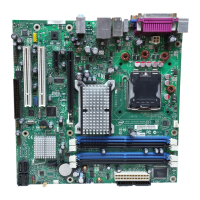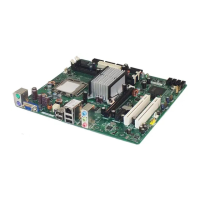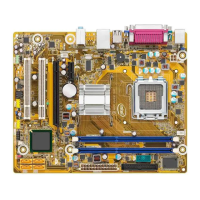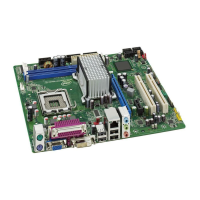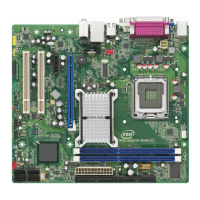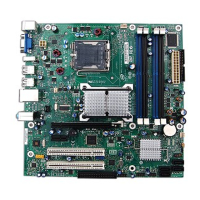
Do you have a question about the Intel DG965RY and is the answer not in the manual?
| Form Factor | Micro ATX |
|---|---|
| Socket Type | LGA 775 |
| Memory Type | DDR2 |
| Memory Slots | 4 |
| Maximum Memory | 8 GB |
| Storage Interface | SATA 3.0 Gb/s |
| IDE Ports | 1 |
| USB Ports | 8 |
| Audio | Realtek ALC883 |
| LAN | Gigabit Ethernet |
| Graphics | Intel GMA X3000 |
| Chipset | Intel G965 Express Chipset |
| Expansion Slots | 1 x PCI Express x16, 3 x PCI |
Describes the physical layout and labeling of the major components on the desktop board DG965RY.
Details processor support for the LGA775 package and where to find compatible models.
Explains supported memory types, configurations, capacities, and specifications for the board.
Outlines the main components of the Intel G965 Express Chipset.
Details the two separate, mutually exclusive graphics options for the G965 chipset.
Lists the features and specifications of the Intel GMA X3000 integrated graphics controller.
Describes the 6-channel audio subsystem, including its features and connectors.
Lists the capabilities of the board's Super I/O controller.
Details the Gigabit Ethernet LAN controller and its functions.
Explains the number of USB 2.0 ports and their compatibility.
Lists the available expansion slots such as PCI Express and PCI connectors.
Covers the purpose, functionality, and storage of the system BIOS.
Describes features for monitoring and controlling hardware aspects like fan speed and temperature.
Details power management implementations, including ACPI and hardware support.
Explains how the LAN subsystem can enable remote wake-up of the computer.
Describes the Suspend-to-RAM feature for quick system wake-up.
Explains the system's ability to wake from an ACPI S3 state using USB devices.
Explains waking the system from an ACPI S3 state via PS/2 keyboard or mouse.
Covers minor components like the speaker, battery, and real-time clock.
Provides essential safety and handling guidelines before performing installation procedures.
Details the process of installing the I/O shield into the computer chassis.
Guides on how to physically install and remove the motherboard from the computer chassis.
Provides step-by-step instructions for installing and removing the CPU.
Guides on how to install and remove RAM modules (DIMMs) from the motherboard.
Instructions for installing and removing PCI Express x16 expansion cards.
Explains how to connect IDE devices, such as hard drives and CD-ROM drives.
Details the connection process for Serial ATA drives to the motherboard.
Shows the location and pin assignments for various internal motherboard headers.
Specific instructions for connecting to the green serial port header.
Guides on connecting front panel power LEDs to the appropriate header.
Details connections for front panel power switches, LEDs, and reset buttons.
Instructions for connecting USB devices via internal USB 2.0 headers.
Explains how to connect chassis fans and power supply cables to the motherboard.
Describes how to configure BIOS settings using the motherboard's jumper block.
Provides step-by-step instructions to clear BIOS user and supervisor passwords.
Instructions for safely replacing the CMOS coin-cell battery.
Guide for updating the system BIOS from within the Windows environment.
Explains where and how to download the necessary BIOS update files.
Instructions for updating the BIOS using a bootable CD-ROM created from an ISO image.
Steps to update the BIOS using the Iflash utility and bootable media like USB drives.
Information on how to restore the BIOS if an update process is interrupted or fails.
Lists beep codes and their meanings for diagnosing POST errors.
Explains common error messages displayed by the BIOS during the Power-On Self-Test.
Lists the safety standards and regulations the desktop board complies with.
Details the board's conformity with applicable EU directives for CE marking.
Provides information on environmental responsibility and Intel's product recycling program.
Outlines compliance with Electromagnetic Compatibility (EMC) regulations.
Shows various product certification marks and their meanings.


